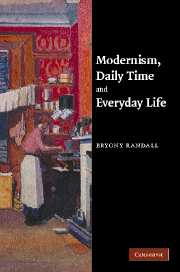Book contents
- Frontmatter
- Contents
- Acknowledgements
- List of abbreviations
- Introduction: dailiness
- Chapter 1 The contemporary context: Henri Bergson and William James
- Chapter 2 Dailiness in Dorothy Richardson's Pilgrimage
- Chapter 3 Re-creation, work and the everyday in Gertrude Stein
- Chapter 4 War-days: H.D., time and the First World War
- Chapter 5 Reading, writing and thinking: a Woolfian daily life
- Afterword
- Notes
- Bibliography
- Index
Chapter 2 - Dailiness in Dorothy Richardson's Pilgrimage
Published online by Cambridge University Press: 22 September 2009
- Frontmatter
- Contents
- Acknowledgements
- List of abbreviations
- Introduction: dailiness
- Chapter 1 The contemporary context: Henri Bergson and William James
- Chapter 2 Dailiness in Dorothy Richardson's Pilgrimage
- Chapter 3 Re-creation, work and the everyday in Gertrude Stein
- Chapter 4 War-days: H.D., time and the First World War
- Chapter 5 Reading, writing and thinking: a Woolfian daily life
- Afterword
- Notes
- Bibliography
- Index
Summary
INTRODUCTION: RICHARDSON, BERGSON, TIME AND GENDER
While the resurgence of interest in the work of Dorothy Richardson is thanks primarily to her reassessment by feminist critics, from Sydney Janet Kaplan in the 1970s to Joanne Winning's recent study The Pilgrimage of Dorothy Richardson, feminist responses to Richardson have by no means been unreservedly positive. Both Elaine Showalter and Rachel Blau DuPlessis reserve some unusually intense criticism for Richardson's thirteen-volume novel Pilgrimage, and their criticism focuses on, or seems related to, what DuPlessis calls the ‘really excessive’ length of the text. Similarly, Showalter's general frustration with Richardson for not producing the progressive feminist text that she, Showalter, believes Richardson might have done centres on Richardson's lack of courage, as Showalter sees it: specifically, ‘Most of all, Richardson's art is afraid of an ending.’ What is particularly surprising about this kind of criticism is that the crimes of which Richardson is accused, of fear and of excess, are the kind of feminised traits – feminised and therefore conventionally seen as negative – which feminist criticism has a tradition of reappraising. Here DuPlessis and Showalter deploy these terms in voices resonant with precisely the kind of patriarchal ideology they want to challenge.
- Type
- Chapter
- Information
- Modernism, Daily Time and Everyday Life , pp. 59 - 91Publisher: Cambridge University PressPrint publication year: 2007



